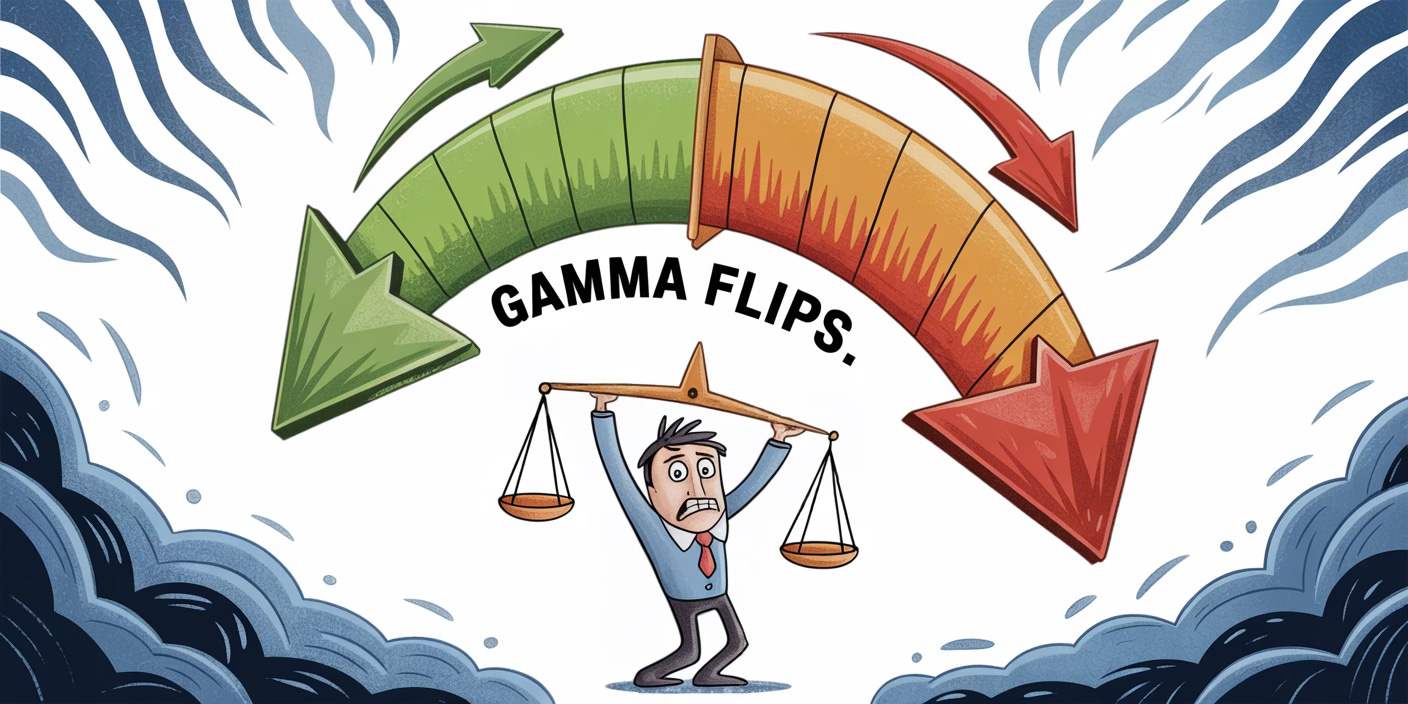Beneath the Surface
Picture the market like the ocean.
The waves you see are daily stock price moves.
But underneath, powerful currents shape everything.
Those invisible undercurrents are gamma — the hidden current created by options traders and market makers.
Negative vs Positive Gamma
Gamma measures how aggressively market makers hedge their risk from the options they’ve sold to traders — we say “sold” because most traders are buying options.
When investors buy calls or puts, someone has to take the other side of that trade.
That “someone” is usually a market maker — a firm like Citadel — who sells the options and then constantly buys or sells the underlying stock to keep their overall position neutral.
The way they hedge depends on whether they are in negative or positive gamma:
The Gamma Flip — The Line Between Calm and Chaos
The Gamma Flip Point marks where the overall options market shifts from positive to negative gamma.
Above the flip: Positive gamma → Dealers’ hedging fights against price movement — it dampens volatility and stabilizes the market.
Below the flip: Negative gamma → Dealers’ hedging chases the price — it adds fuel to momentum and makes moves larger and faster.
Think of it as the tide line:
Above it, the water is smooth; below it, the current pulls harder with every move.
You can find this level each day on free dashboards.
It’s often the single most important line on the chart for understanding market mood.
When markets first enter a negative gamma environment, the initial reaction is almost always downward, as dealer hedging and rising volatility feed on each other.
After that first wave plays out, gamma becomes a volatility amplifier, driving both the panic down and the sharp rebound that follows.
Negative Gamma — Below the Flip
Negative gamma usually appears after markets start falling.
When stocks drop, volatility spikes, and option values rise — this flips dealers into short gamma.
Here’s the chain reaction:
Prices fall → Dealers sell stock to hedge their short puts.
Their selling pushes prices lower, creating more hedging pressure.
Feedback loop forms — the lower it goes, the more they must sell.
This is why down moves under negative gamma are fast, emotional, and self-feeding.
But this doesn’t last forever.
Eventually, selling pressure slows, traders start buying, and dealers’ hedges unwind in reverse.
Then comes the snapback:
Dealers buy to rebalance.
Volatility collapses.
The rebound accelerates — often violently.
So yes — negative gamma does align with falling markets initially,
but once that feedback loop burns out, the reverse feedback can trigger some of the sharpest rallies in history.
Positive Gamma — Above the Flip
Above a key level known as the Gamma Flip, dealers’ hedging becomes stabilizing instead of reactive.
In this positive gamma zone:
Dealers buy when prices dip, sell when prices rise.
This absorbs volatility
Breakouts fade, ranges tighten, and volatility stays muted.
That’s why quiet, steady uptrends usually happen in positive gamma conditions — the “shock absorbers” are working.
How to Trade Gamma Flips
When the market drops below the flip, expect higher volatility and fast moves.
Don’t rush to fade the first drop — wait until momentum slows, then look for a reversion back toward the flip.
That’s where call buying can make sense — not because it’s bullish, but because the feedback loop unwinds upward.
Example: Reading a Real Gamma Map
Let’s imagine that today’s SPX gamma levels look like this:
How to Interpret It
Above 6500 (Positive Gamma):
The market is in the “calm zone.” Dealers’ hedging absorbs volatility — they buy dips and sell rips.Below 6500 (Negative Gamma):
The market enters a “chaotic zone.” Dealer hedging now chases price moves — selling into declines, buying into rallies.
Volatility expands, trends extend, and false reversals become common.Lower Range (6400–6450):
This is the “danger zone.” Dealer hedging becomes very one-sided, and liquidity thins out.
That’s where panic spikes or squeezes often occur — violent, fast, and emotional moves in both directions.
Why Gamma Dashboards Show Upper, Flip, and Lower Wall
Most gamma services publish three main zones each day:
Think of it as a volatility map:
Above the flip, the market feels sticky and controlled.
Below it, it feels unanchored and emotional.
Near the lower wall, it’s often near exhaustion, where the next big rebound can begin.
Near the upper wall, dealer hedging typically caps further upside, causing upward price to slow or stall.
Quick Practical Example
Let’s say SPX opens at 6520 — above the 6500 flip.
You’re in positive gamma. Expect a calm, pinned market.
If SPX drifts to 6550, that’s near the upper gamma zone — a logical place for resistance.
But if SPX sells off to 6450, it’s now below the flip — negative gamma territory.
Expect faster, wider moves and more intraday volatility.
If price stabilizes around 6450 and starts turning up, that can spark a gamma squeeze back toward 6500.
So one number — the flip — changes everything about how you interpret the market’s mood.
Conclusion
Negative gamma appears during falling markets and amplifies their speed.
Once the selling slows, those same flows reverse, fueling powerful rebounds.
Positive gamma creates calm, stable trading ranges — ideal for mean-reversion strategies.
The Gamma Flip separates those two worlds — watch it like a weather front.







